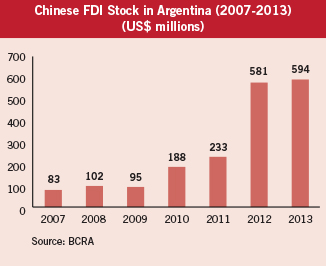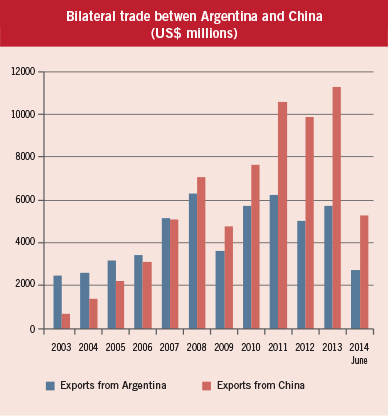Bilateral economic relations between the Argentine Republic and the PRC have undergone a quantitative leap in the past 10 years.
After decades of relatively low levels of trade – at best secondary in terms of significance – in the past decade, international trade figures between the two countries rose exponentially thanks to the growth and strengthened trade relations of both economies within their respective development processes.

Investment Promotion Director of the Undersecretariat for Investment Development and Trade Promotion,
Argentina’s Ministry of Foreign Affairs and Worship
The growth of these business ties in trade, investment and tourism represents not only a huge opportunity for Argentina, but also an important challenge posed by the strong differences in the scale and technological development in the two countries’ economies.
In the past decade, trade between Argentina and China increased fivefold, exceeding US$17 billion in 2013, making China Argentina’s second-largest trading partner. During the same period, bilateral trade relations recorded a pendulum swing, shifting from a trade surplus of US$1.8 billion in 2003 for Argentina to a deficit of more than US$5 billion in 2013.
The trade between the countries also reflects a strong asymmetry in terms of added value and technological content of the exchanged goods.
Almost 90% of Argentine exports to China is composed mainly of soybeans (56%), crude cooking oil (12.4%), and soybean oil (10%), while Chinese exports to Argentina are composed mainly of high-tech goods such as telephone electrical devices and their parts (21%), and machinery for data processing and their parts (10.2%), within a highly diversified export basket that ranges from motorcycles and rolling stock to capital goods of different specifications for different industry sectors.
Investments, although incipient, also recorded a strong increase in the past decade. The most recent figures available suggest that China is the 13th-largest foreign investor in Argentina, Chinese foreign direct investment stock in Argentina has risen sevenfold since 2007 to almost US$600 million; however, investment announcements on record suggest an even higher figure.
In terms of composition, Chinese investments in Argentina are led by financial, mining and hydrocarbon sectors, although important investments were made in electrical appliances and high-tech sectors. The most emblematic case was the establishment of Huawei’s South American regional headquarters in Argentina in 2014.
In this scenario, the main challenge for the favourable evolution of this bilateral relationship is finding mechanisms to reach a dynamic balance that will allow balanced trade in the short to medium term, and generate the conditions needed for both countries to push forward their economic development processes as a result of trade and investment.
Due to the governments’ level of consensus and the degree of friendship both nations have institutionalised through several international treaties – many of them signed during the visit of President Xi Jinping to Argentina in June 2014 – Argentina is confident that bilateral economic relations with China will continue to deepen, generating mutually beneficial conditions.
In this regard, bilateral treaties signed by Argentina and China in June 2014 established the foundation for long-term joint development, promoting Chinese investments in sectors with high export potential to China, and directing Chinese funding to investments in infrastructure, which will increase Argentina’s level of competitiveness, improving its international standing to position its products.
Examples include the award of two large infrastructure projects, one in the energy sector and the other in logistics, the construction of the Kirchner-Cepernic hydroelectric dam, and the modernisation of the Belgrano Cargas, a freight network that connects 17 Argentine provinces.
The Kirchner-Cepernic hydroelectric dam, which will demand works for close to US$4.7 billion to generate 1,740MW, was awarded to a joint venture composed of Electroingeniería, Gezhouba Group and Hidrocuyo. The logistics project represents an investment of US$2.5 billion, 90% of which will be channelled through the Chinese Machinery and Equipment Corporation.
Moreover, as the ongoing and future investment process will not resolve the short-term trade balance, the agreements between Argentina and China propose immediate solutions by establishing financial tools that make up for flow imbalances.
The most emblematic case is the currency swap agreement signed by the Central Bank of Argentina and the People’s Bank of China in an amount of US$10 billion. This agreement has improved the prior agreement by making terms more flexible, reducing costs and authorising additional uses.
The natural potentialities that arise from these two economies’ great complementarity and joint government initiatives in a context of friendship and understanding, where both governments have shown their propensity for creating mutually beneficial conditions, means the future for business development is fertile ground, and the Argentine government invites private parties to expand their investments to participate in the prosperous future on the horizon.
Argentina Ministry of
Foreign Affairs and Worship
Esmeralda 1212 – Piso 6
Ciudad Autónoma de Buenos Aires
(C1005AAG) República Argentina
电话 Tel: 54 11 4819 7904
传真 Fax: 54 11 4819 7904
电子信箱 E-mail:
info@inversiones.gov.ar
www.inversiones.gov.ar






















